the history of yeovil's pubs
PUBS HOME PAGE |
PUBS INTRODUCTION |
PUBS BY NAME |
BEERHOUSES |
cow inn (2)
7 South Street
There's not too much information available about the Cow Inn (marked 'H' on the map below) but I'm guessing it was not operating for long before the records I found beginning in 1835. A note made by LC Hayward indicates a Cow Inn in 1697, however this was almost certainly a different establishment since Watts 1806 map of Yeovil shows the site occupied by the Cow Inn in South Street as empty space.
It is almost certain, from the records surviving, that the Cow Inn under discussion began life as a beerhouse. It was one of the many South Street inns and stood immediately next door to the Greyhound Inn, roughly in the location of today's small Post Office car park in South Street.
Unfortunately the first photograph I've found of the Cow Inn is that below in which the inn itself is masked by the horse-drawn omnibus standing outside. Nevertheless the second and third photographs show that the Cow Inn was a small, detached and double fronted building under a thatched roof with a small shop-style window to one side of the front door.
As seen below, the Cow Inn was still operating in 1906 but then soon disappears from the records, probably as a result of the death of its last landlord, Frederick Langdon, combined with the Licensing Act 1904 and, by the time of the 1911 census, it was listed as a private dwelling and was the childhood home of Percy Winsor. It was demolished in the 1930's.
![]()
The first licensee, William Jeans, is listed in the Beer Houses section of the Somerset Gazette Directory of 1840 although he doesn't appear to be listed in the 1841 census and neither does the Cow Inn. A 65-year old rope manufacturer called William Jeanes was living in Middle Street according to the 1851 census but whether it is the same William is not clear.
There's a little more information on the next licensee, George Brown, who was born in Yeovil about 1823. In the 1851 census his occupation is given as a mason and he was living in Bond Street with his glove sewer wife, Louisa, and two young sons, William aged 3 and George aged 1. By 1859 he is listed in Hunt's Directory as the licensee of the Cow Inn. By 1861 three daughters had been added to their family, Mary, Alma and Louisa and George gave his occupation in the census as beer retailer and mason. George died in the winter of 1870 and in the 1871 census Louisa is listed as the innkeeper and living in the Cow Inn with two of her daughters, Mary and Louisa. In 1875 the Post Office Directory listed a Mrs Elizabeth Brown as a beer retailer, but this is assumed to be a mistake with the forename. By 1881 the two Louisa's were living at 6 South Western Terrace, the mother described as an annuitant (a person who receives income from an insurance annuity) and the daughter, a milliner.
Thomas Knott was born in Watton, Norfolk around 1853 the son of an agricultural labourer whose name really was - wait for it - Middle Nott (yes, that's what I thought too!). Anyway, despite being burdened by a father whose name was apparently taken at random from the "Boy's Book of Useful Things to Do with String", by 1881 Thomas had moved to Yeovil and was licensee of the Cow Inn. He lived with his Yeovil-born wife "H" (I'm afraid the census was no more helpful than that) and their two daughters "A" and "KM". Thomas described his occupation as bricklayer and innkeeper. Although Thomas is listed as the licensee in Whitby's 1882 Yeovil Almanack Advertiser the family must have moved very shortly thereafter to Chelsea, London, because in the 1891 census "KM" who, it transpires, was called Kate was listed as being born in Chelsea (although we all know she wasn't!). It also transpires that Thomas' wife "H" was really called Harriet but "A", apparently, was by then called Louisa?? There was also a new daughter, Maud, who was presumably called "M" by her appellatively-dysfunctional family.
The following licensee, John Mitchell, was born around 1858 in Tiverton, Devon, the son of hairdresser Henry Mitchell and his wife, Elizabeth, who was eighteen years his junior. At the age of twelve John had left home and was one of two apprentice basket makers in Thorverton, Devon being taught by 74-year old basket maker Thomas Norman and his son-in-law, Robert Jarmin. By 1881 John, by now unmarried but a qualified basket maker, was living in Exeter and boarding with the family of basket maker Henry Way. By the time of the 1891 census all had changed for John, he had married Elizabeth, and they moved to Yeovil where they had two sons and two daughters aged 5, 4, 3 and 2. They lived at the Cow Inn where John was described as a licensed victualler and basket maker. By 1895 John had moved on from the Cow Inn and was listed as the licensee of the London Inn in Hendford in Kelly's Directory of 1895. By 1901 he and his family, now with an additional two daughters, were living in Beer Street where John described his occupation as a withy basket maker.
In the meantime the license of the Cow Inn was taken on by its final licensee, Frederick Langdon. Frederick was born in 1848, the son of master mason Samuel Langdon and his wife, Eliza, in Preston Plucknett, Yeovil, where Samuel and Eliza lived with their seven children. During the next ten years two more children were added to the brood but Samuel died and by 1861 Frederick lived with his mother and eight of his siblings. At the age of twelve, Frederick was an apprentice cabinetmaker. By 1871 Eliza was living with just two of her sons, Frederick and Francis (known as Frank), both unmarried, in their early twenties and both cabinetmakers. In 1881 Eliza and Frank were still in Preston Plucknett but Frederick had moved on - I just couldn't locate him in the 1881 census records but I caught up with him in 1891 in London, where he was living with his sister Ellen and her family in St Georges, Hanover Square. Frederick was still working as a cabinetmaker and his brother-in-law, David Morgan, was a joiner so they presumably worked together. By the time of the 1901 census, Frederick had moved back to Yeovil, he was aged 49, listed as married and now the inn keeper of Cow Inn.
Now, concentrate, as this is where it gets a bit complicated - next door, in the Greyhound Inn, lived Annie Braine whose husband, Frederick Braine, was the son of Charity Braine, the licensee of the Greyhound. Charity died in 1895 and, I assume, Fred and Annie Braine took on the license of the Greyhound until Fred Braine died in March 1897 at which time Annie Braine was the sole licensee. Annie Braine married Fred Langdon in January 1898 and the couple ran both pubs until Fred Langdon's death in 1906. After this date Annie, now Annie Langdon, ran the Greyhound, probably until her death in 1936, aged 74.
map
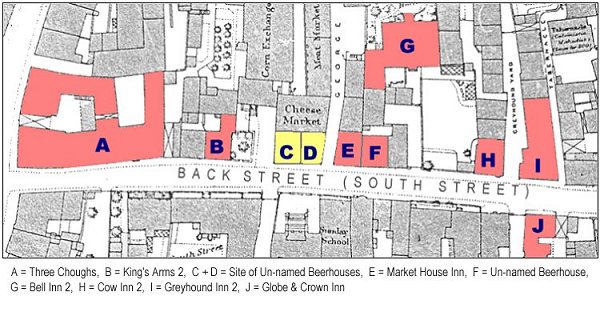
gallery

This colourised photograph
features in my
book 'Yeovil
From Old
Photographs'
Taken taken before 1879, this photograph by Adam Gosney shows the Greyhound Hotel at extreme right (before being rebuilt in its present form), the Cow Inn next door, the Globe and Crown opposite and the Three Choughs Hotel in the far distance at the end of South Street. Between the Cow Inn and the Choughs was the two-storey King's Arms 2 in the far distance as well as a couple of un-named beerhouses. Then the three-storey Market House Inn and then another un-named beerhouse. Just think, what an ideal pub crawl. Note the horse-drawn omnibus parked outside the Greyhound.
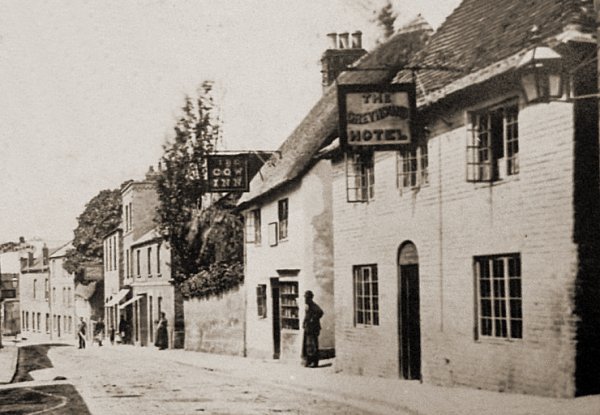
Another photograph of South Street taken around 1880 showing the Cow Inn and the Greyhound Hotel. The man is standing at the entrance to Greyhound Yard, a small 'court' of low quality housing.
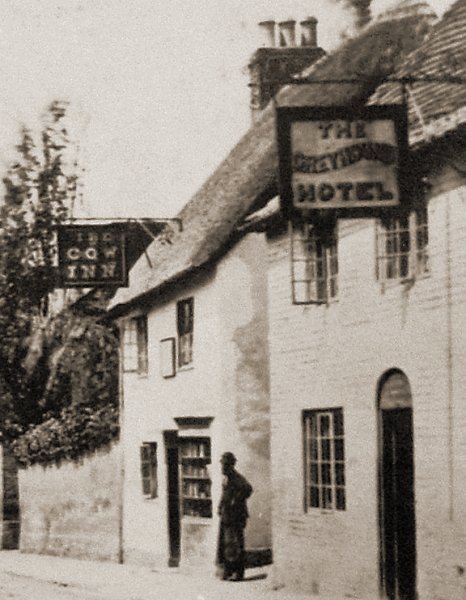
An enlargement of the Cow Inn from the previous photograph. Do you reckon that's Tom Knott standing outside?
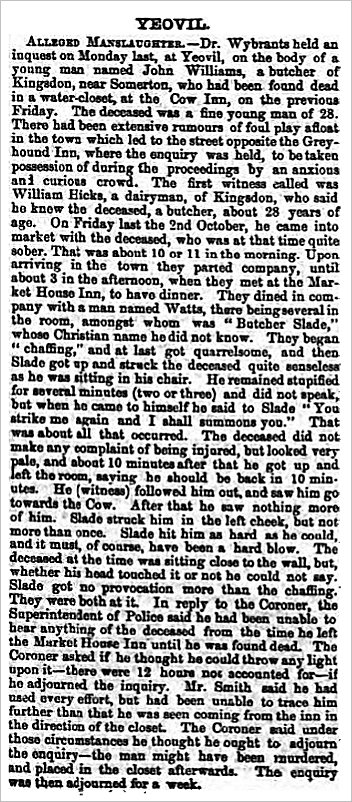
A murder at the Cow Inn? - an interesting snippet from the 9 October 1868 edition of the Shepton Mallet Journal.
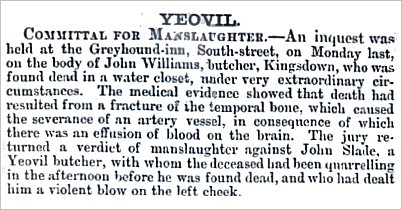
John Slade was brought up on a charge of manslaughter according to this report from the Salisbury and Winchester Journal's edition of 17 October 1868.
licensees
1835 – Licensee
not named
(Robson's 1835
Somerset
Directory - Beer
Houses) listed
as Cow
1840 – William
Jeans (Somerset
Gazette 1840
Directory - Beer
Houses) listed
as Cow
1859 – George
Brown (Hunt & Co
1859 Directory -
Beer Retailers)
listed as Cow,
South Street
1861 – George
Brown – Beer
Retailer & Mason
(1861 census)
pub not named
1861 – George
Brown – Beer
Retailer and
Shopkeeper
(Kelly's 1861
Directory)
1866 – George
Brown – Beer
Retailer and
Shopkeeper (1866
Post Office
Directory)
1871 – Louisa
Brown (widow age
45) – Innkeeper
(1871 census)
name not listed
1872 – Mrs
Louisa Brown –
Beer Retailer
and Shopkeeper
(Kelly's 1872
Directory)
1875 – Mrs
Louisa Brown –
Beer Retailer
(Kelly's 1875
Directory)
1875 – Mrs
Elizabeth Brown
– Beer Retailer
(1875 Post
Office
Directory)
listed in South
Street
1881 – Thomas
Knott –
Bricklayer &
Innkeeper (1881
census) listed
as Cow Inn
1882 – Thomas
Knott (Whitby's
1882 Yeovil
Almanack
Advertiser)
listed as Cow
Inn
1884 – EJ Hooper –
License transfer
(Borough Petty
Sessions,
September)
1884 – HH Hooper –
License
transferred
(Borough Petty
Sessions,
September)
1891 – John
Mitchall –
Licensed
Victualler &
Basket Maker
(1891 census)
listed as Cow
Inn
1901 – Frederick
Langdon – Inn
Keeper (1901
census) listed
as Cow Inn
1911 – listed as
Private House
(1911 census)